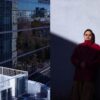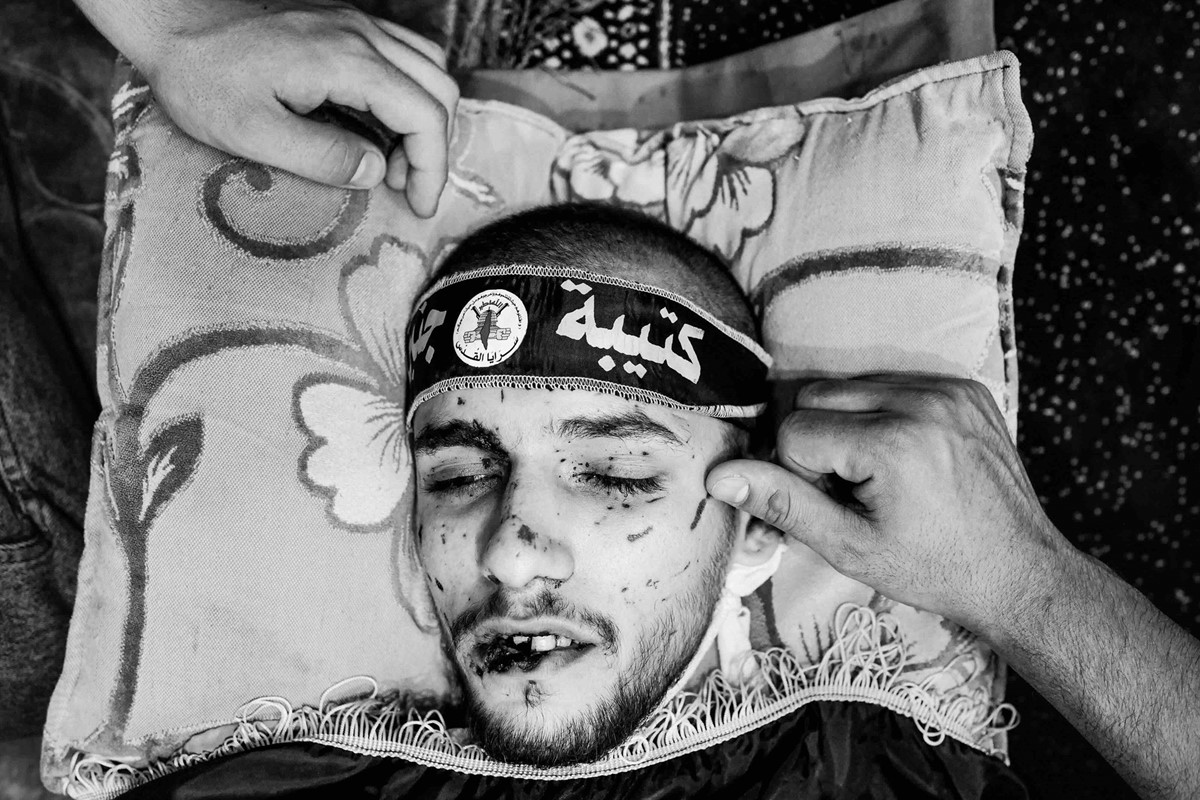
Rewrite
Lead ImageMahmoud Khaled al- Ar’arawi. Jenin Refugee camp, Palestine, 2023© Sakir Khader / Magnum Photos
Sakir Khader’s lens is sharp and sensitive. Since 2021, the Palestinian-Dutch photographer has documented men, women and children in the West Bank’s Jenin and Nablus. He counts many as friends, returning repeatedly to the same homes within the Jenin refugee camp. His images are sometimes stark black and white, with powerful gazes returned to the camera by playful groups of children, men on horseback, and companions with intertwined arms. Through these searing photographs, Khader also channels the death that permeates the land: some are taken against a backdrop of rubble, others feature close-ups of men clutching guns, and he homes in on deep scars, physical or psychological, that have been forged by Israel’s munitions.
“My photography is simply what I see – sometimes life, sometimes death, and the uncertain space in between,” he tells AnOther ahead of his first institutional show, Yawm al-Firak, at Foam in Amsterdam. “My camera is both a witness and a weapon, a means of documenting the unfolding reality of my homeland. I capture the moments we are living through now, and, inevitably, the moments of grief – because that, too, is a truth we cannot turn away from.”
Yawm al-Firak (Arabic for ‘Day of Separation’) focuses on seven mothers who are each grieving a son. The exhibition includes Khader’s portraits of each son: a young Ashraf al-Saadi looks soulfully into the lens the same year he was murdered by a drone strike on the outskirts of Jenin; Yassine and Ahmad relax among a group of men who casually smile to camera, smoke a cigarette, and scroll a phone, three days before they were both killed by an Israeli strike. There are also stirring photographs of farewell ceremonies and affectionate video interviews led by Khader.
“I began speaking with the mothers, many of whom were curious about my constant presence,” he tells me. “They would ask, ‘What brings you from safe Holland to us here?’, aware that I was a visitor from beyond these streets. My family is from Nablus, but I grew up in the Netherlands. I would tell them I am here to document, to ensure no one forgets, to archive a history that, since the Nakba and long before, has remained painfully unchanged under brutal occupation. They would invite me for tea, and we’d sit with their children. I knew all their sons. Every mother became like my own. I spent time with young men who, not long after, were murdered by Israeli forces. And their mothers saw that I always came back. This was never a business relationship. They were never merely my subjects. They are my people, the people of my beloved homeland.”
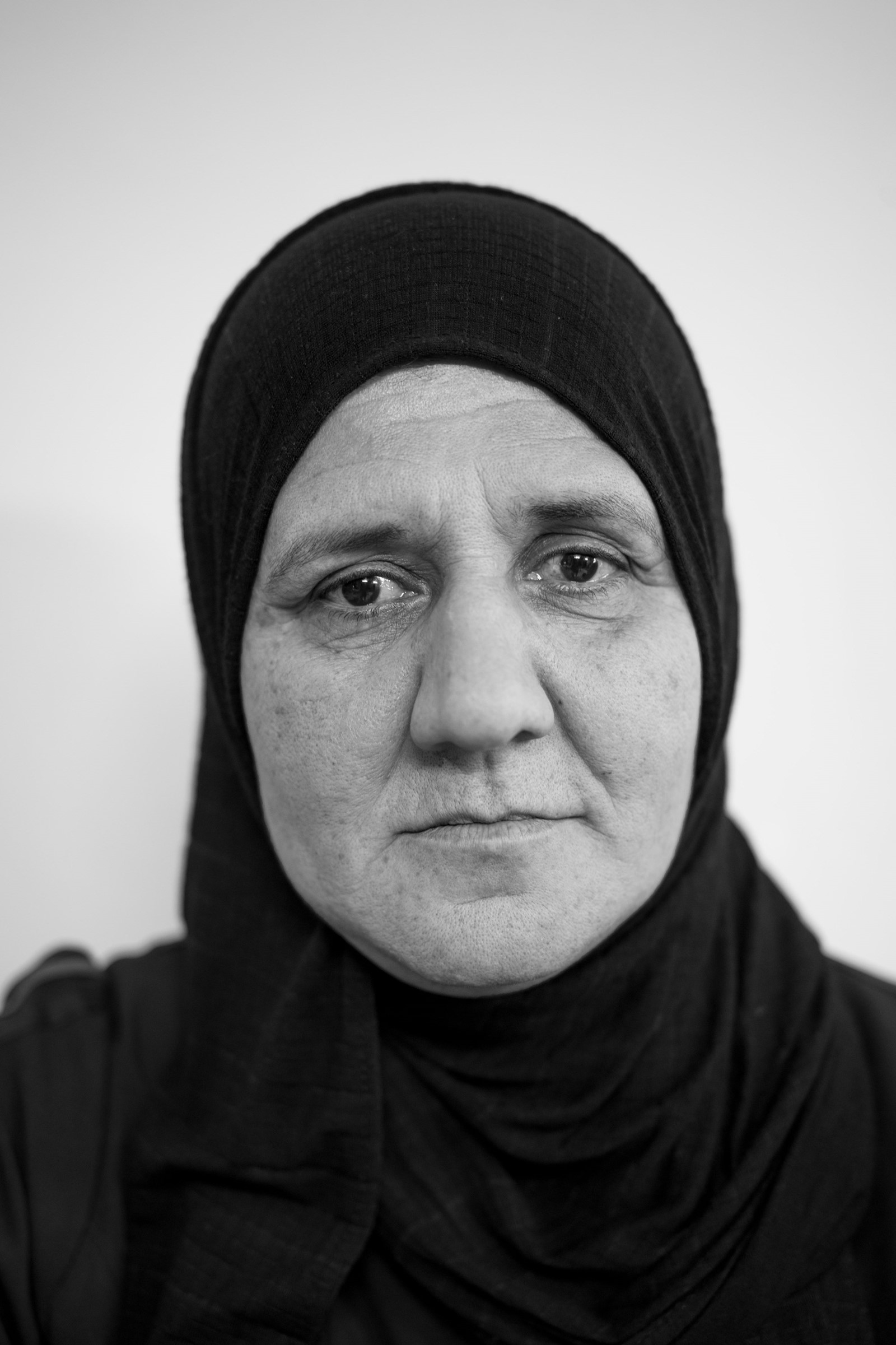
Yawm al-Firak focuses on the intense love and resilience that Khader has observed. Each mother is shown withstanding a horrific level of pain and his images simultaneously bring forth the power of the community. There is a tenderness and solidarity between these women, who sometimes literally hold each other up.
“I always try to portray them not as victims, but as women who refuse to surrender – to an occupation that seeks to break them by killing their children,” he says. “They are told, ‘You are the mothers of terrorists. This is what happens when your sons resist.’ The goal is to drive them to despair, to make them question their very existence. But I show them as they are: proud, strong, unwavering. And yet, in their eyes, there is an inescapable pain. It’s important to capture both, to reveal the scars etched deep into their souls.”
While Yawm al-Firak focuses on individual women, it also communicates the wider position of the mother within Palestinian society. “For us, the mother is the most sacred part of a man’s heart,” says Khader. “If something happens to her, life loses its meaning. A Palestine without mothers would mean no resistance, no children, no men. Mothers do not simply nurture the resistance; they are the resistance. They are the foundation of our society, and when they are harmed – when their children are taken, imprisoned, or murdered – it ignites a deep, unshakable rage. How dare they touch our women like this? How dare they take from them, torment them, try to break their spirit? It is not just an assault on them, but on all of us.”
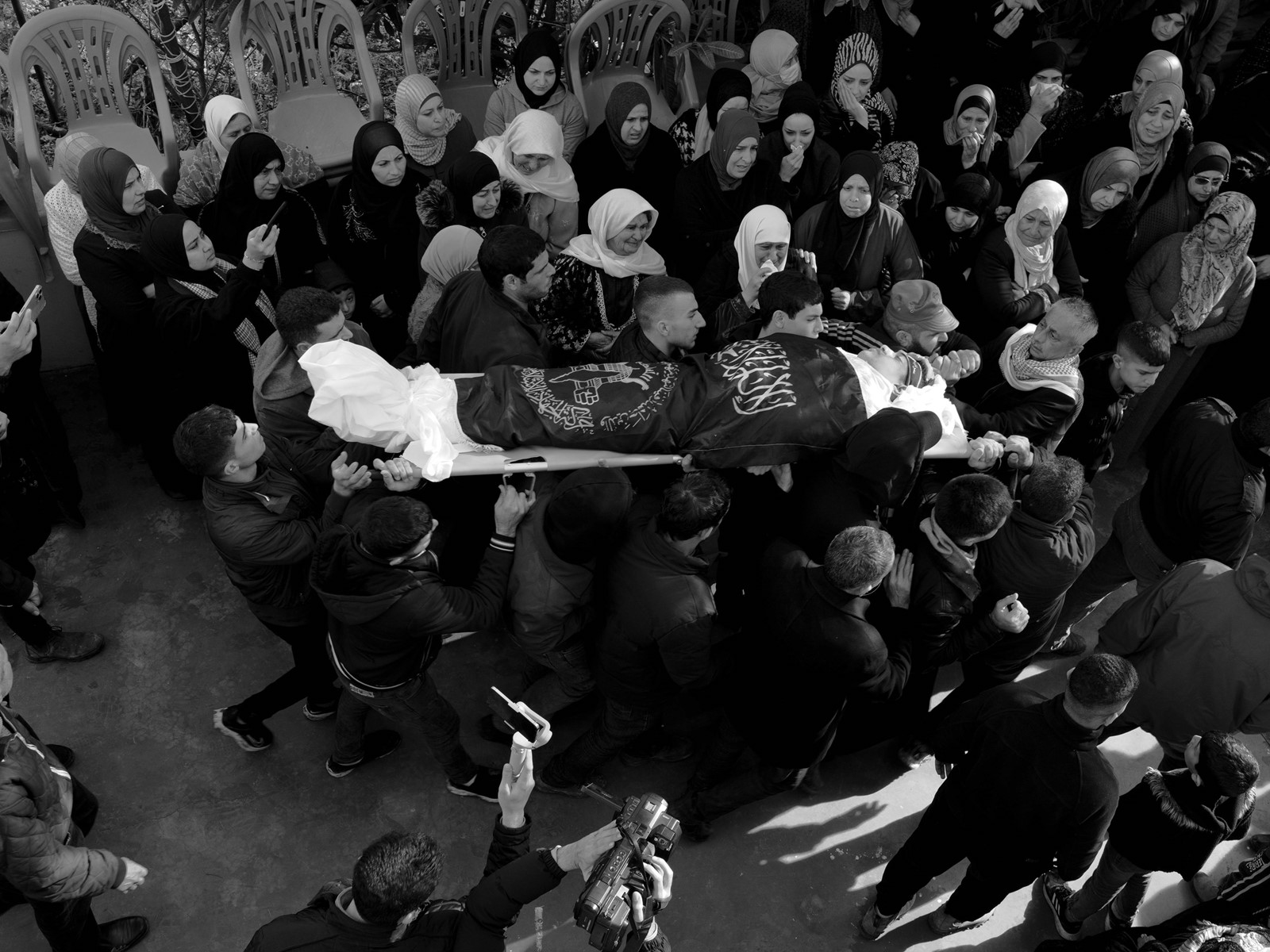
The fact that each of these women is grieving a son highlights the unrelenting violence that Palestinian boys and men endure. Israel’s routine mass abduction and torture of those in Gaza and the West Bank is largely unreported in mainstream media, despite prolific video evidence existing online. Khader’s photographs speak to the grief of mothers and the injustice of their sons’ death.
“The men are suffering. They are being imprisoned, bombed, forced to carry the bodies of their own children,” he says. “This suffering knows no gender, no religion, no age. When they bomb, they do not discriminate. Some of the mothers in this exhibition were never given the chance to say farewell. The Israelis took their sons’ bodies, withholding even the dignity of a final goodbye. But a mother knows when her son has been killed. And in seizing his body, they do not just kill him, they kill her soul all over again. As if taking her child wasn’t enough, they take her last act of love, her right to mourn.”
Khader also challenges Islamophobic messaging that is perpetuated by Western leaders and media. In particular, he confronts the way language is perverted. He uses the word “martyr” when writing about his work and has subsequently been accused of glamorising death and terrorism. This criticism has also been levelled at his photographs of resistance fighters holding guns, and he recently discovered he had been added to a terror watchlist in the United States.
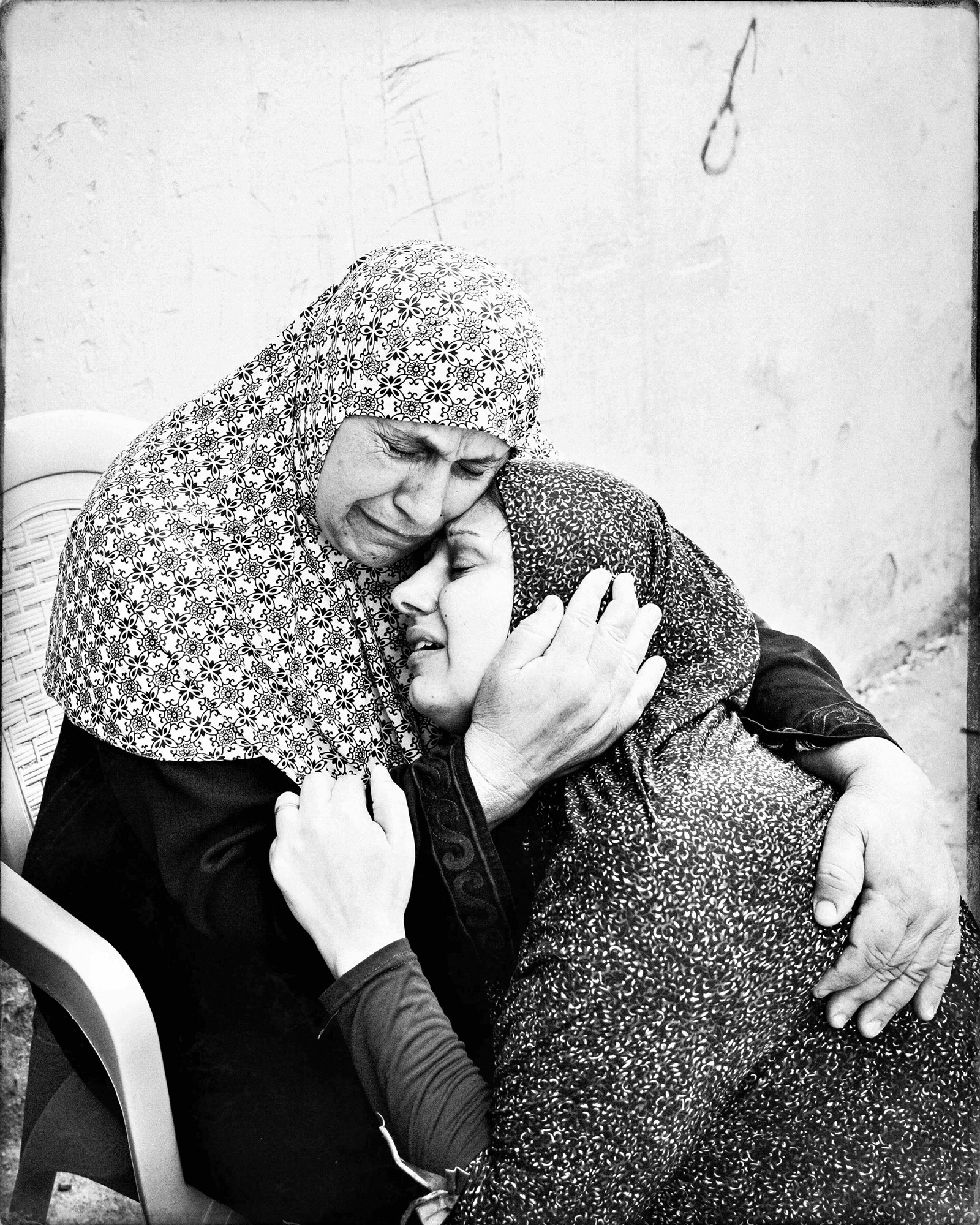
“They do not respect another people’s language or culture,” he says. “In Arabic, we say shahid, meaning ‘witness.’ We believe a martyr, a shahid, bears witness to injustice and will stand before God to testify to what has happened. The Kurds use this word. The Iraqi army uses it. Even the Jews and Americans use the word ‘martyr.’ But if you are Muslim, suddenly you are accused of glorifying terrorism. That, too, is a form of occupation – not just of land, but of language, of thought. They seek to colonise even the way we speak, the way we remember, the way we mourn.”
Khader’s work has gradually gained a global following online and he is the first Palestinian photographer to join Magnum. His exhibition at Foam is a rare, nuanced depiction of Palestinian life within a European institution. He hopes that it will put forth a more human side of the West Bank than many visitors see in the news. Ultimately, he views his role within this as more than a photographer, but a witness to the attempted destruction of his homeland and its people.
“When I stand in a room with grieving mothers, sometimes I am simply a witness. If one day something happens to me, I will stand before God and tell Him what happened in that room – how I saw these mothers suffering, grieving, somehow accepting the weight of their pain. It is always deeply emotional. They are the people of my homeland, and so I bear witness to the injustice unfolding there. In that sense, I, too, am a living shahid – a witness to the suffering, to the truth that cannot be erased.”
Yawm al-Firak by Sakir Khader is on show at Foam in Amsterdam until 14 May 2024.
in HTML format, including tags, to make it appealing and easy to read for Japanese-speaking readers aged 20 to 40 interested in fashion. Organize the content with appropriate headings and subheadings (h1, h2, h3, h4, h5, h6), translating all text, including headings, into Japanese. Retain any existing
tags from
Lead ImageMahmoud Khaled al- Ar’arawi. Jenin Refugee camp, Palestine, 2023© Sakir Khader / Magnum Photos
Sakir Khader’s lens is sharp and sensitive. Since 2021, the Palestinian-Dutch photographer has documented men, women and children in the West Bank’s Jenin and Nablus. He counts many as friends, returning repeatedly to the same homes within the Jenin refugee camp. His images are sometimes stark black and white, with powerful gazes returned to the camera by playful groups of children, men on horseback, and companions with intertwined arms. Through these searing photographs, Khader also channels the death that permeates the land: some are taken against a backdrop of rubble, others feature close-ups of men clutching guns, and he homes in on deep scars, physical or psychological, that have been forged by Israel’s munitions.
“My photography is simply what I see – sometimes life, sometimes death, and the uncertain space in between,” he tells AnOther ahead of his first institutional show, Yawm al-Firak, at Foam in Amsterdam. “My camera is both a witness and a weapon, a means of documenting the unfolding reality of my homeland. I capture the moments we are living through now, and, inevitably, the moments of grief – because that, too, is a truth we cannot turn away from.”
Yawm al-Firak (Arabic for ‘Day of Separation’) focuses on seven mothers who are each grieving a son. The exhibition includes Khader’s portraits of each son: a young Ashraf al-Saadi looks soulfully into the lens the same year he was murdered by a drone strike on the outskirts of Jenin; Yassine and Ahmad relax among a group of men who casually smile to camera, smoke a cigarette, and scroll a phone, three days before they were both killed by an Israeli strike. There are also stirring photographs of farewell ceremonies and affectionate video interviews led by Khader.
“I began speaking with the mothers, many of whom were curious about my constant presence,” he tells me. “They would ask, ‘What brings you from safe Holland to us here?’, aware that I was a visitor from beyond these streets. My family is from Nablus, but I grew up in the Netherlands. I would tell them I am here to document, to ensure no one forgets, to archive a history that, since the Nakba and long before, has remained painfully unchanged under brutal occupation. They would invite me for tea, and we’d sit with their children. I knew all their sons. Every mother became like my own. I spent time with young men who, not long after, were murdered by Israeli forces. And their mothers saw that I always came back. This was never a business relationship. They were never merely my subjects. They are my people, the people of my beloved homeland.”

Yawm al-Firak focuses on the intense love and resilience that Khader has observed. Each mother is shown withstanding a horrific level of pain and his images simultaneously bring forth the power of the community. There is a tenderness and solidarity between these women, who sometimes literally hold each other up.
“I always try to portray them not as victims, but as women who refuse to surrender – to an occupation that seeks to break them by killing their children,” he says. “They are told, ‘You are the mothers of terrorists. This is what happens when your sons resist.’ The goal is to drive them to despair, to make them question their very existence. But I show them as they are: proud, strong, unwavering. And yet, in their eyes, there is an inescapable pain. It’s important to capture both, to reveal the scars etched deep into their souls.”
While Yawm al-Firak focuses on individual women, it also communicates the wider position of the mother within Palestinian society. “For us, the mother is the most sacred part of a man’s heart,” says Khader. “If something happens to her, life loses its meaning. A Palestine without mothers would mean no resistance, no children, no men. Mothers do not simply nurture the resistance; they are the resistance. They are the foundation of our society, and when they are harmed – when their children are taken, imprisoned, or murdered – it ignites a deep, unshakable rage. How dare they touch our women like this? How dare they take from them, torment them, try to break their spirit? It is not just an assault on them, but on all of us.”

The fact that each of these women is grieving a son highlights the unrelenting violence that Palestinian boys and men endure. Israel’s routine mass abduction and torture of those in Gaza and the West Bank is largely unreported in mainstream media, despite prolific video evidence existing online. Khader’s photographs speak to the grief of mothers and the injustice of their sons’ death.
“The men are suffering. They are being imprisoned, bombed, forced to carry the bodies of their own children,” he says. “This suffering knows no gender, no religion, no age. When they bomb, they do not discriminate. Some of the mothers in this exhibition were never given the chance to say farewell. The Israelis took their sons’ bodies, withholding even the dignity of a final goodbye. But a mother knows when her son has been killed. And in seizing his body, they do not just kill him, they kill her soul all over again. As if taking her child wasn’t enough, they take her last act of love, her right to mourn.”
Khader also challenges Islamophobic messaging that is perpetuated by Western leaders and media. In particular, he confronts the way language is perverted. He uses the word “martyr” when writing about his work and has subsequently been accused of glamorising death and terrorism. This criticism has also been levelled at his photographs of resistance fighters holding guns, and he recently discovered he had been added to a terror watchlist in the United States.

“They do not respect another people’s language or culture,” he says. “In Arabic, we say shahid, meaning ‘witness.’ We believe a martyr, a shahid, bears witness to injustice and will stand before God to testify to what has happened. The Kurds use this word. The Iraqi army uses it. Even the Jews and Americans use the word ‘martyr.’ But if you are Muslim, suddenly you are accused of glorifying terrorism. That, too, is a form of occupation – not just of land, but of language, of thought. They seek to colonise even the way we speak, the way we remember, the way we mourn.”
Khader’s work has gradually gained a global following online and he is the first Palestinian photographer to join Magnum. His exhibition at Foam is a rare, nuanced depiction of Palestinian life within a European institution. He hopes that it will put forth a more human side of the West Bank than many visitors see in the news. Ultimately, he views his role within this as more than a photographer, but a witness to the attempted destruction of his homeland and its people.
“When I stand in a room with grieving mothers, sometimes I am simply a witness. If one day something happens to me, I will stand before God and tell Him what happened in that room – how I saw these mothers suffering, grieving, somehow accepting the weight of their pain. It is always deeply emotional. They are the people of my homeland, and so I bear witness to the injustice unfolding there. In that sense, I, too, am a living shahid – a witness to the suffering, to the truth that cannot be erased.”
Yawm al-Firak by Sakir Khader is on show at Foam in Amsterdam until 14 May 2024.
and integrate them seamlessly into the new content without adding new tags. Ensure the new content is fashion-related, written entirely in Japanese, and approximately 1500 words. Conclude with a “結論” section and a well-formatted “よくある質問” section. Avoid including an introduction or a note explaining the process.
